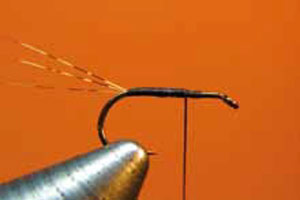Tyrrell's Comparaduns - Irish Angler Magazine July 2013
- by Irish Fly Craft Admin
-

This is Jimmy Tyrrell’s favourite time in the fly fishing calendar, when there is normally an abundance of fly life on our rivers and loughs. And these are his favourite patterns.
Blue winged olives and sedges are usually plentiful, so hopefully it will be the case for the rest of the summer, although so far this year the insect life has not been that plentiful on my local rivers. There’s not been as much activity as you would normally find at this time of year. I think the seasons are running behind due to the long winter that we had, but hopefully we will have some decent fishing ahead of us in the last few months of the season.
I use quite a few different small dry patterns to match the hatch, but one of my favourite styles has to be the Comparadun. There are a number of different styles for these patterns with deer hair and CDC being the most common materials for the wing on the fly. The body material can be anything from different dubbings, quill or goose and turkey biots. The latter makes a superb segmented body, but is very fragile, so if you are using biots put some varnish or superglue on the hook shank before winding up.
They are quite simple to tie, as there is very little material required. Basically, all you need are fibres for the tail, dubbing or other for the body and material for the wing and thorax. Coq de Leon is probably one of the better materials for the tail if you can acquire it. The fibres are quite stiff and have that lovely barred effect. Two to three fibres are all that is required.
It’s very important to get the body shape correct. A very gradual taper from the tail is required as this is what the trout see from beneath the surface. Also the size of hook choice is very important. I would normally use 16 and upwards for my local rivers, but for some waters you can go down in size. For instance, if I was fishing the Liffey I would go down a size, so it pays to make a few enquiries if you are fishing waters that you’ve never fished before.
The thing I love about these patterns is that they look so natural to the fish. They sit perfectly in the surface film of the water just like the emerging insect.
The other good thing about these patterns is that you can change the colours and materials to imitate a large number of different olive patterns. One particular pattern that I use for a lot of my river just has an olive dubbing body and thorax, a CDC wing and a bit of flash at the tail. If I want to change it I just alter the body colour.
I like my Comparaduns to sit right in the surface film so the body of the fly must not be overdressed. Keep it slim and nicely tapered to the eye of the hook. I like to use the Partridge dry fine wire hooks for these patterns as they have a nice wide gape on them and the fly sits nicely in the surface.
The Comparadun style gives a few different variations to the fly as it can represent different stages. It can imitate the dun floating downriver or the spent stage of the fly where you drift it down into those slower channels in the river where the trout tend to lie in wait for any insects that float down.
When the blue winged olives are on I seldom use any other pattern, as these Comparaduns work very well for me most of the time. But don’t forget, you’ll always get those days when the fish won’t bite. We’ve all had them and probably will have more to come. That’s the beauty of fly fishing!
"The thing I love about these patterns is that they look so natural."



Tyrrell's Comparadun
| Hook: | Size 18-12 Partridge E1A dry fine wire hook down eye |
| Tail: | Coq de Leon or any stiff feather fibres |
| Body: | Turkey or goose biots |
| Wing: | CDC |
| Thorax: | Olive rabbit or superfine dubbing |
Tying Instructions
 Step One: Wind on the thread, then tie in three strands of your chosen tail material.
Step One: Wind on the thread, then tie in three strands of your chosen tail material. Step Two: Catch in the CDC plumes for the wing.
Step Two: Catch in the CDC plumes for the wing.TIP 1: Before adding the CDC wing cut the ends so that they are straight and even.
 Step Three: Cut the remaining fibres and cover with the tying thread.
Step Three: Cut the remaining fibres and cover with the tying thread. Step Four: Build up the body from the tail to the wing.
Step Four: Build up the body from the tail to the wing.TIP 2: Make sure to give the body a nice taper from the tail.
 Step Five: Catch in a piece of biot for the body.
Step Five: Catch in a piece of biot for the body. TIP 3: Before winding up the biot add a drop of varnish to the body.
 Step Six: Wind the biot up in touching turns to give a nice segmented effect.
Step Six: Wind the biot up in touching turns to give a nice segmented effect. Step Seven: Dub on some dubbing for the thorax.
Step Seven: Dub on some dubbing for the thorax. Step Eight: Wind up the dubbing behind and in front of the wing.
Step Eight: Wind up the dubbing behind and in front of the wing. Step Nine: Whip finish and varnish.
Step Nine: Whip finish and varnish.




